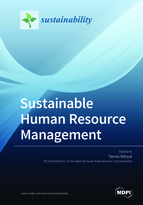Sustainable Human Resource Management
A special issue of Sustainability (ISSN 2071-1050).
Deadline for manuscript submissions: closed (31 May 2019) | Viewed by 138686
Special Issue Editor
Interests: transportation; supply chain; city logistics; optimization; logistics; Industry 4.0; intelligent transportation systems
Special Issues, Collections and Topics in MDPI journals
Special Issue Information
Dear Colleagues,
The concept of sustainability is important for companies both in the case of SMEs and worldwide multinational companies. Some key factors to help a company achieve its sustainability objectives are based on human resource management. Sustainable human resource management is a typical cross-functional task that becomes more and more important at the strategic level of a company. Industry 4.0 technologies, Internet of Things and competitive demands as signs of globalization have led to significant changes across the organizational structures and human resource strategies of companies. The increasing importance of sophisticated human resource strategies in the life of companies and the intention to find optimal design and operation strategies for sustainable human resource management were a motivation for launching this Special Issue.
We invite researchers from the global scientific community to contribute original research papers, as well as review articles and empirical studies that will stimulate debate on this topic.
Assoc. Prof. Tamás Bányai
Guest Editor
Manuscript Submission Information
Manuscripts should be submitted online at www.mdpi.com by registering and logging in to this website. Once you are registered, click here to go to the submission form. Manuscripts can be submitted until the deadline. All submissions that pass pre-check are peer-reviewed. Accepted papers will be published continuously in the journal (as soon as accepted) and will be listed together on the special issue website. Research articles, review articles as well as short communications are invited. For planned papers, a title and short abstract (about 100 words) can be sent to the Editorial Office for announcement on this website.
Submitted manuscripts should not have been published previously, nor be under consideration for publication elsewhere (except conference proceedings papers). All manuscripts are thoroughly refereed through a single-blind peer-review process. A guide for authors and other relevant information for submission of manuscripts is available on the Instructions for Authors page. Sustainability is an international peer-reviewed open access semimonthly journal published by MDPI.
Please visit the Instructions for Authors page before submitting a manuscript. The Article Processing Charge (APC) for publication in this open access journal is 2400 CHF (Swiss Francs). Submitted papers should be well formatted and use good English. Authors may use MDPI's English editing service prior to publication or during author revisions.
Keywords
- strategic human resource management
- corporate social responsibility
- sustainable work systems
- talent management
- optimization of sustainable human resource management strategies
- staff deployment and staffing
- employee promotion






